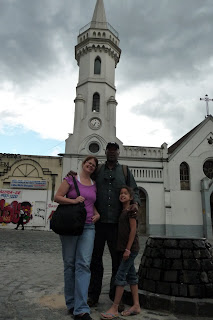 In many ways, Curitiba is regarded as the crown jewel of the country. It is the largest city in southern Brasil, it rivals Sao Paulo in corporate investments, it has one of the highest standards of living in the country, and it contains the best educated population in Brasil. Many people attribute the higher standard of living and better educated citizenry to the significant infusion of immigrants who came from Germany, Italy, Poland, Ukraine and Japan in the early part of the 20th century.
In many ways, Curitiba is regarded as the crown jewel of the country. It is the largest city in southern Brasil, it rivals Sao Paulo in corporate investments, it has one of the highest standards of living in the country, and it contains the best educated population in Brasil. Many people attribute the higher standard of living and better educated citizenry to the significant infusion of immigrants who came from Germany, Italy, Poland, Ukraine and Japan in the early part of the 20th century.
 Although it has undergone reconstruction since then, the Portuguese colonial architectural elements have been preserved.
Although it has undergone reconstruction since then, the Portuguese colonial architectural elements have been preserved.
Also located in the Largo do Ordem, which means Square of the Order (as in church), is the Museu de Arte Sacra. This museum, although small, is dedicated to the collection and presentation of sacred artifacts in the Catholic Church. Remarkably, there is no entrance fee and we were the only people visiting at the time. The collection primarily consists of chalices, cruz processionals, images of Christ in crucifixion and the Virgin Mary. Most of the objects had been donated by the church to the museum and most are from the 18th-20th centuries.
One item in particular caught my attention, mostly due to its age. Encased in glass and mounted on a wall stood a 17th century cruz processional, likely to have been produced in Portugal and shipped over to Brasil during the mid-1600s. At 6 feet high, it consisted of solid silver, and was engraved with tremendous detail. In the center was a handle for the priest to hold during the ceremony. In the quiet darkness of the museum gallery, questions tumbled around in my imagination: How many hands have been positioned on that handle over the hundreds of years since it was created? And who were those men? What were their dreams and aspirations? When they held this object what were their thoughts? And what, truly, was their love for the Lord?
As I was unable to take photos inside the museum, this image example comes from another website at www.sever-vouga.net/.../artesacra/cruzrocas.jpg.  Behind David, Hope and I stands the Museu de Arte Sacra. At our side is a small fountain known as the Bebedouro do Ordem, which dates to the 18th century. Apparently back in the 1700s, when Curitiba was just a sleepy colonial ranching town, the tropeiros and ranchers used to lead their horses and mules to drink in this trough. The outside is constructed of stones, while inside there is an iron bowl to hold the water. Today it is a watering trough for pigeons, which isn't nearly as romantic as its origins.
Behind David, Hope and I stands the Museu de Arte Sacra. At our side is a small fountain known as the Bebedouro do Ordem, which dates to the 18th century. Apparently back in the 1700s, when Curitiba was just a sleepy colonial ranching town, the tropeiros and ranchers used to lead their horses and mules to drink in this trough. The outside is constructed of stones, while inside there is an iron bowl to hold the water. Today it is a watering trough for pigeons, which isn't nearly as romantic as its origins.


No comments:
Post a Comment